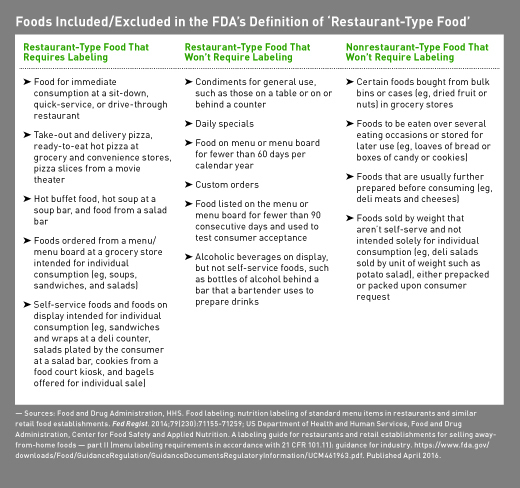Web Exclusive
Navigating the New Menu Labeling Changes
By Jessica Levings, MS, RDN
The deadline is fast approaching for restaurants to comply with the new labeling regulations that involve posting calorie and nutrition information for the food they sell on menus and menu boards.
In 2010, section 4205 of the Patient Protection and Affordable Care Act amended the Federal Food, Drug, and Cosmetic Act to require calorie labeling on menus and menu boards of chain restaurants. On December 1, 2014, the FDA released the final rule, "Food Labeling; Nutrition Labeling of Standard Menu Items in Restaurants and Similar Retail Food Establishments," requiring chain restaurants and similar retail food establishments with 20 or more locations, doing business under the same name, and offering for sale substantially the same menu items, to provide calorie information for standard menu items (including food on display and self-service food).1 Additional written nutrition information, including calories, calories from fat, total fat, saturated fat, trans fat, cholesterol, sodium, total carbohydrate, dietary fiber, sugars, and protein, must be provided upon request.
Lastly, menus and menu boards must state, "2,000 calories a day is used for general nutrition advice, but calorie needs vary," and provide a statement about the availability of written nutrition information upon request. Restaurants must comply with these requirements by May 5, 2017, and consumers will start seeing calories posted on menus for covered establishments on or before this date.
"Restaurants and similar retail food establishments (covered establishments)" include bakeries, cafeterias, coffee shops, convenience stores, delis, foodservice facilities located within entertainment venues (such as amusement parks, bowling alleys, and movie theatres), foodservice vendors (such as in malls), food take-out and/or delivery places (such as pizza take-out and delivery establishments), grocery stores, retail confectionary stores, superstores, quick-service restaurants, and table-service restaurants. Schools serving meals under the National School Lunch or Breakfast Programs, inpatient only foodservice facilities, and food trucks aren't included as covered establishments.

Considerations for Dietitians
Dietitians have been instrumental in helping restaurants comply with the menu labeling requirements. "Clients come to me with questions about craft beers and other items not specifically named in the guidelines. I've also helped them figure out the best way to present the information within the guidelines but for different scenarios from catering to in-restaurant dining. RDs can help managers work through grey areas," says Marisa Moore, MBA, RDN, an Atlanta-based consultant and owner of Marisa Moore Nutrition. Dietitians also can help restaurants make their offerings more healthful. "Importantly, RDs who are also skilled in recipe development can help restaurants identify and create new healthful options to add to the menu," Moore says.
The law currently requires calories to be displayed for foods prepared and offered for sale, including items such as whole pizzas. However, the Common Sense Nutrition Disclosure Act of 2017 recently was reintroduced to Congress and, if passed, would allow covered establishments to choose how calorie information is displayed, meaning they could pick whether calories are displayed for the whole pizza or just by the slice.2 It also would allow restaurants that receive most of their orders online, such as pizza restaurants, to display calories only from remote locations like websites, instead of on the menus in the restaurants. To amend the Common Sense Nutrition Disclosure Act of 2017, the FDA would have to develop a new set of rules and compliance would take years.
"It's nice that diners will have more access to basic nutrition information about the foods they eat at many of the nation's chain restaurants," Moore says. "It may help bring awareness and serve as a resource for those wanting to make healthier choices when eating away from home."
While it's too soon to tell how these requirements will impact consumer purchasing decisions while dining out, dietitians can help educate clients on healthful calorie ranges for meals so consumers can gauge what's appropriate, and how much is too much for one meal.
— Jessica Levings, MS, RDN, is a freelance writer and owner of Balanced Pantry, a consulting business helping companies develop and modify food labels, conduct recipe analysis, and create nutrition communications materials. Learn more at www.balancedpantry.com, Twitter @balancedpantry, and Facebook.com/BalancedPantry1.
References
1. Food and Drug Administration, HHS. Food labeling; nutrition labeling of standard menu items in restaurants and similar retail food establishments. Final Rule. Fed Regist. 2014;79(230):71155-71259.
2. 115th Congress (2017–2018). S.261 — Common Sense Nutrition Disclosure Act of 2017. Congress.gov website. https://www.congress.gov/bill/115th-congress/senate-bill/261. Published February 1, 2017.
